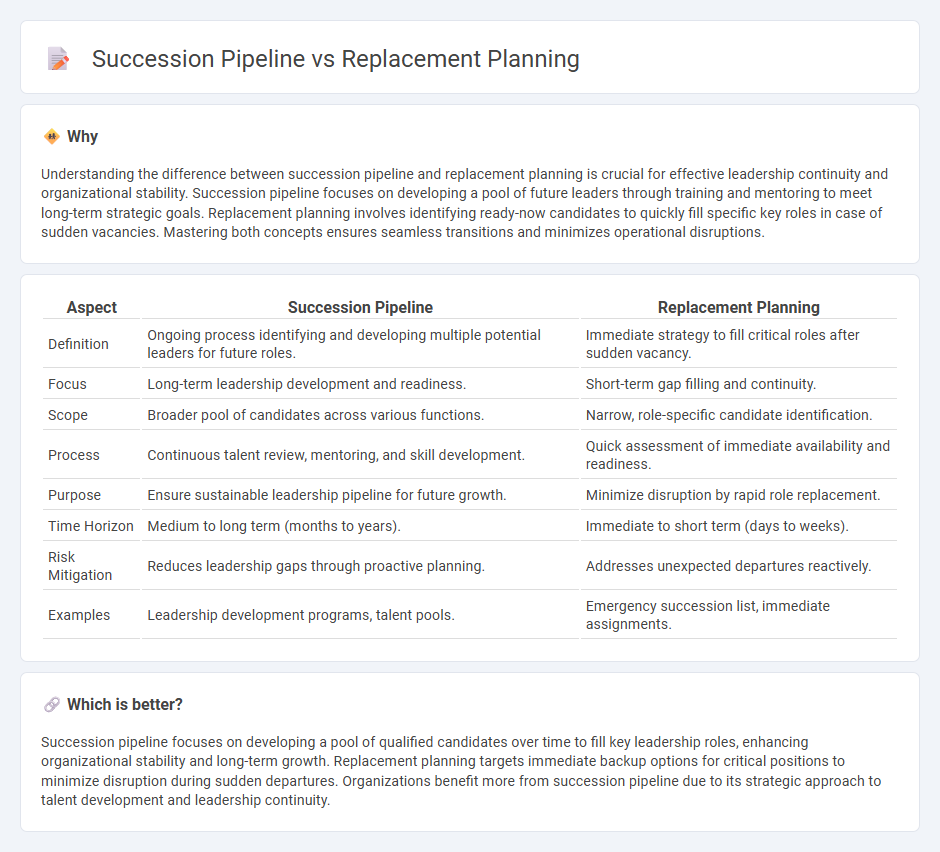
Succession pipeline focuses on developing internal talent over time to fill critical leadership roles, emphasizing long-term growth and readiness. Replacement planning identifies immediate backups for key positions to ensure business continuity during unexpected departures. Explore how strategic succession pipeline integration can enhance organizational resilience and leadership stability.
Why it is important
Understanding the difference between succession pipeline and replacement planning is crucial for effective leadership continuity and organizational stability. Succession pipeline focuses on developing a pool of future leaders through training and mentoring to meet long-term strategic goals. Replacement planning involves identifying ready-now candidates to quickly fill specific key roles in case of sudden vacancies. Mastering both concepts ensures seamless transitions and minimizes operational disruptions.
Comparison Table
| Aspect | Succession Pipeline | Replacement Planning |
|---|---|---|
| Definition | Ongoing process identifying and developing multiple potential leaders for future roles. | Immediate strategy to fill critical roles after sudden vacancy. |
| Focus | Long-term leadership development and readiness. | Short-term gap filling and continuity. |
| Scope | Broader pool of candidates across various functions. | Narrow, role-specific candidate identification. |
| Process | Continuous talent review, mentoring, and skill development. | Quick assessment of immediate availability and readiness. |
| Purpose | Ensure sustainable leadership pipeline for future growth. | Minimize disruption by rapid role replacement. |
| Time Horizon | Medium to long term (months to years). | Immediate to short term (days to weeks). |
| Risk Mitigation | Reduces leadership gaps through proactive planning. | Addresses unexpected departures reactively. |
| Examples | Leadership development programs, talent pools. | Emergency succession list, immediate assignments. |
Which is better?
Succession pipeline focuses on developing a pool of qualified candidates over time to fill key leadership roles, enhancing organizational stability and long-term growth. Replacement planning targets immediate backup options for critical positions to minimize disruption during sudden departures. Organizations benefit more from succession pipeline due to its strategic approach to talent development and leadership continuity.
Connection
Succession pipeline and replacement planning are interconnected processes that ensure leadership continuity within an organization. Succession pipelines identify and develop internal candidates for future key roles, while replacement planning focuses on immediate readiness for unforeseen vacancies. Together, they create a strategic framework to maintain organizational stability and support long-term talent management.
Key Terms
Talent Identification
Replacement planning revolves around identifying immediate successors for key roles to ensure business continuity, emphasizing readiness and specific role matching. Succession pipelines broaden this approach by fostering a pool of high-potential talent through ongoing development and strategic workforce planning, focusing on long-term organizational growth. Discover how integrating both strategies optimizes talent identification for sustained leadership success.
Leadership Development
Replacement planning targets immediate leadership gaps by identifying potential successors for key roles, ensuring business continuity during transitions. Succession pipelines emphasize long-term leadership development through targeted training and mentoring, aiming to cultivate a pool of future executives. Explore effective leadership development strategies to optimize both replacement planning and succession pipelines.
Critical Role Mapping
Replacement planning focuses on identifying immediate backups for critical roles to minimize disruption during sudden vacancies, while succession pipelines develop long-term talent pools for future leadership readiness and organizational growth. Critical Role Mapping involves pinpointing key positions essential for business continuity and aligning them with potential internal candidates through competency evaluations and leadership potential assessments. Explore how integrating Critical Role Mapping into succession pipelines can enhance strategic talent management and ensure seamless transitions in your organization.
Source and External Links
Succession Planning vs. Replacement Planning: A Comparative Analysis - Replacement planning is a tactical approach to quickly fill immediate vacancies due to unexpected departures, focusing on short-term operational stability rather than long-term leadership development, which is the goal of succession planning.
It's time for a paradigm shift: Replacement or succession planning - Replacement planning identifies backups for critical roles primarily as a crisis response with focus on current job descriptions, while succession planning involves strategic development of candidates with competencies and leadership potential aligned to future organizational needs.
Succession Planning Vs Replacement Planning - Compliance Prime - Replacement planning responds reactively to immediate vacancies by filling significant roles quickly, often with little employee development, while succession planning proactively develops a pool of internal candidates to ensure long-term organizational resilience.
 dowidth.com
dowidth.com